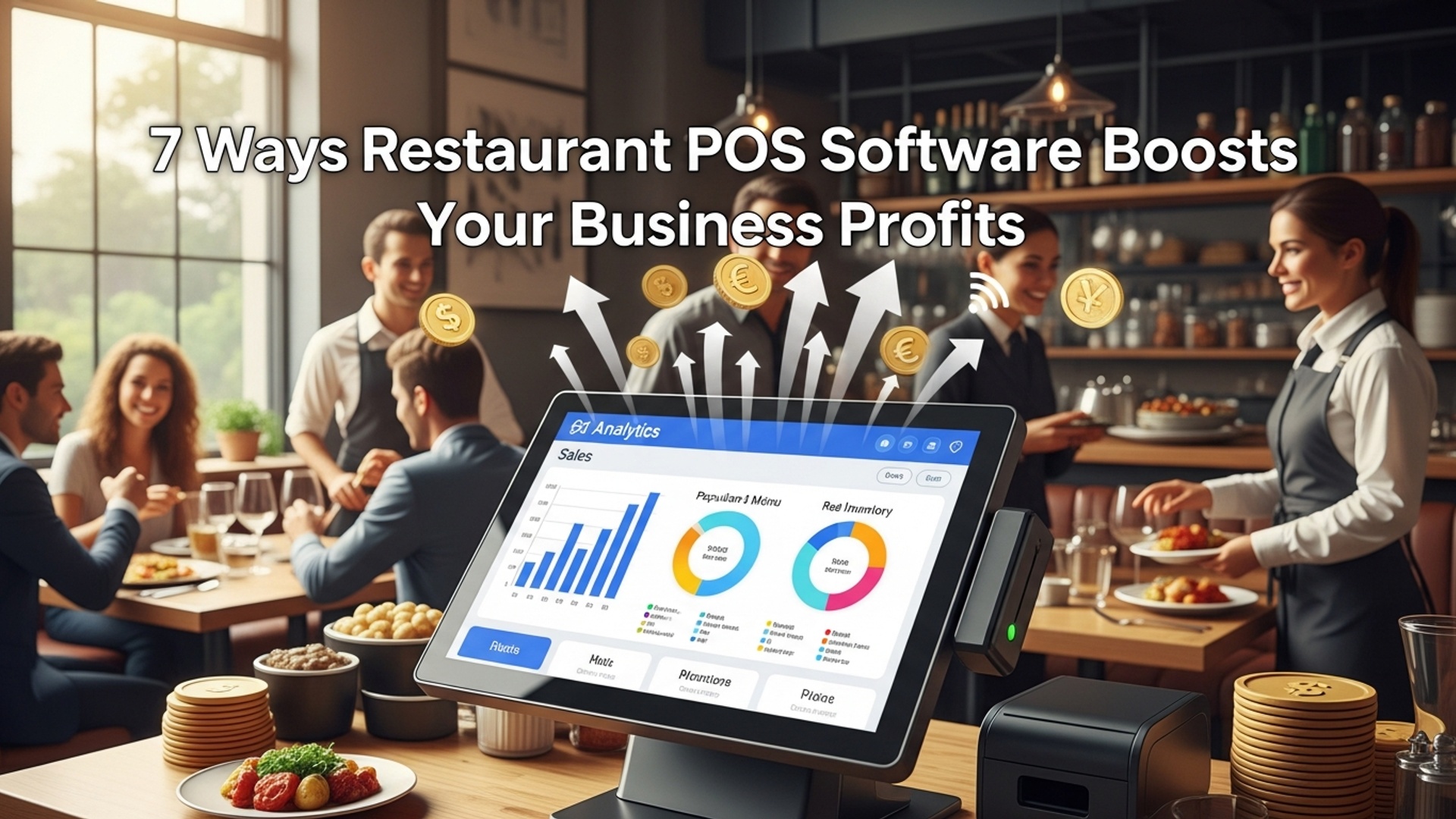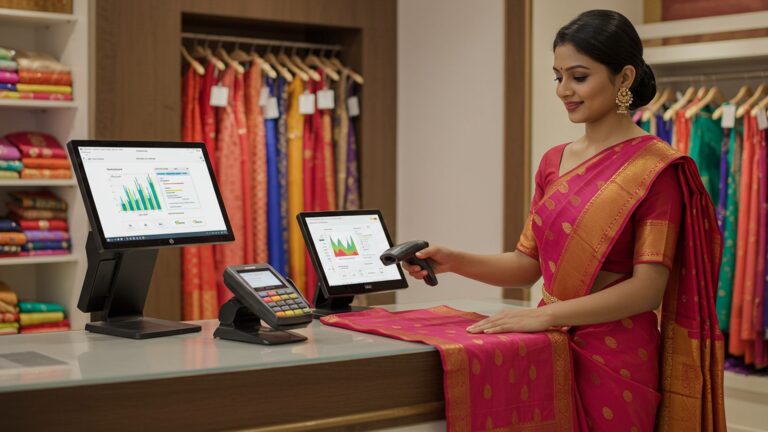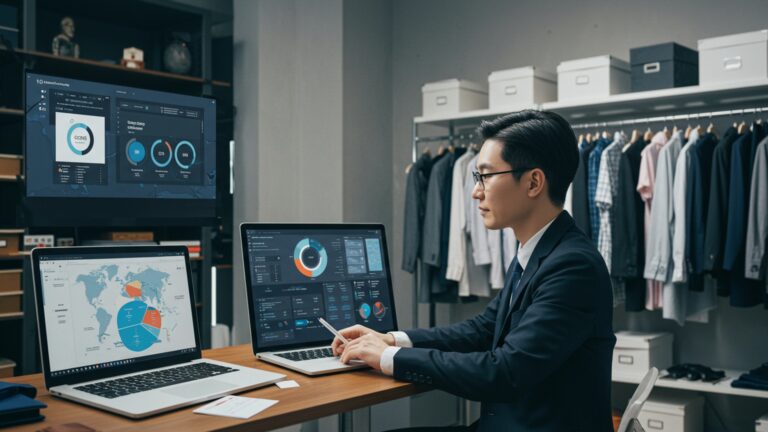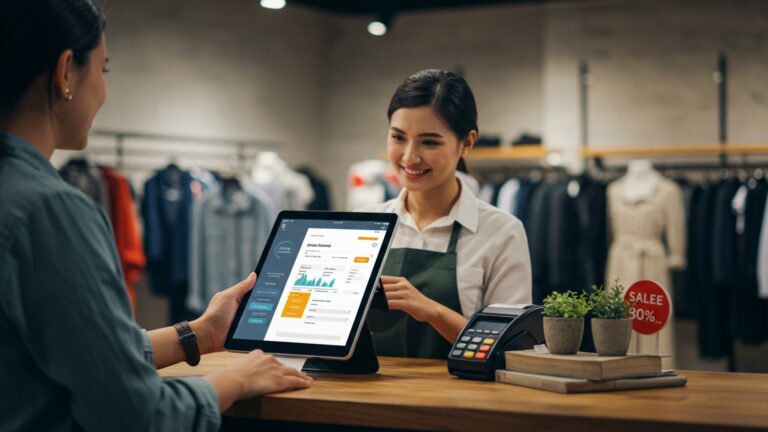7 Ways Restaurant POS Software Boosts Your Business Profits
In today’s fiercely competitive culinary landscape, restaurants constantly battle rising costs and the ever-present demand for seamless customer experiences, where traditional cash registers simply can’t keep pace. Modern restaurant POS software transforms this challenge into a significant profit opportunity, moving far beyond basic order processing to become the central nervous system of your operation. It empowers establishments to optimize everything from real-time inventory tracking, preventing costly waste, to personalizing guest interactions and streamlining kitchen workflows. By leveraging advanced analytics and integrating capabilities like mobile ordering and robust loyalty programs, a cutting-edge POS system directly drives operational efficiency, reduces errors. ultimately enhances revenue streams, positioning your business for sustained growth.

Streamlining Order Management and Accuracy
One of the most immediate and impactful benefits of integrating a modern Restaurant POS software system into your establishment is the radical transformation of order management. Traditional methods, often relying on handwritten tickets or manual entry into disparate systems, are inherently prone to human error, leading to incorrect orders, wasted food. frustrated customers. A robust Restaurant POS software digitizes this entire process, ensuring precision from the moment an order is taken until it reaches the customer’s table.
When a server inputs an order into the POS terminal, it’s instantly and accurately transmitted to the kitchen via a Kitchen Display System (KDS). This eliminates misinterpretations of handwriting, reduces miscommunication between front-of-house and back-of-house staff. ensures that dishes are prepared exactly as requested. For example, a “no onions” request or a “gluten-free” modification is clearly displayed, minimizing the chances of error. This not only saves ingredients but also significantly improves customer satisfaction, fostering loyalty and positive reviews.
Consider a busy Friday night: a server takes an order for Table 7, including a steak cooked medium-rare with a side substitution. With a traditional system, this note might be scribbled, potentially leading to a medium-well steak and the wrong side. With a Restaurant POS software, the order is entered precisely, modifiers are selected from predefined options. the KDS displays it clearly to the kitchen staff, ensuring the guest receives exactly what they ordered. This efficiency translates directly into faster table turnover and happier diners, both critical for boosting profits.
Optimizing Inventory Control and Waste Reduction
Food costs represent a significant portion of a restaurant’s operating expenses. Inefficient inventory management can lead to substantial losses through spoilage, over-ordering, or even theft. Restaurant POS software provides powerful tools for granular inventory control, allowing businesses to track every ingredient and prepared dish with remarkable accuracy.
Modern Restaurant POS software systems include sophisticated inventory modules that monitor ingredient usage in real-time. When a dish is sold, the system automatically deducts the corresponding ingredients from your inventory counts. This capability allows you to:
- Minimize Waste
- Prevent Stockouts
- Identify Discrepancies
- Optimize Vendor Management
By knowing exactly what you have on hand, you can make more informed purchasing decisions, reducing the likelihood of ingredients expiring before they are used. According to a report by ReFED, U. S. restaurants generate an estimated 22 to 33 billion pounds of food waste annually. Implementing a robust POS can significantly cut into these figures.
Real-time inventory alerts can notify you when specific ingredients are running low, prompting timely reorders and preventing situations where popular menu items cannot be served.
By comparing theoretical usage (based on sales) with actual usage (physical counts), you can pinpoint issues like portion control problems, spoilage, or even internal shrinkage, allowing for corrective action.
Some advanced Restaurant POS software can integrate with vendor management, streamlining the ordering process and helping you negotiate better deals by understanding your precise needs.
For instance, imagine a popular seasonal dish. Without precise tracking, you might over-order a specialty ingredient, leading to waste once the season ends. With a Restaurant POS software, you can track its consumption daily, adjusting future orders to match demand precisely, thereby protecting your profit margins.
Enhancing Customer Experience and Loyalty
In today’s competitive culinary landscape, customer experience is paramount. A positive experience doesn’t just encourage a single visit; it fosters loyalty, leading to repeat business and valuable word-of-mouth marketing. Restaurant POS software plays a pivotal role in elevating the customer journey in several key ways.
- Faster Service
- Personalized Service
- Loyalty Programs
- Gift Card Management
Quick order entry and processing mean shorter wait times for customers, particularly during peak hours. Digital receipts and integrated payment processing further expedite checkout.
Advanced Restaurant POS software can integrate with Customer Relationship Management (CRM) systems. This allows staff to access customer order history, dietary preferences. even special occasions (like birthdays) with a few taps. Imagine a server greeting a regular by name and asking if they’d like “the usual” – a touch that builds strong relationships.
Many Restaurant POS software solutions come with built-in or integrated loyalty programs. Customers can earn points, receive exclusive discounts, or get special offers, incentivizing them to return. This data also provides valuable insights into customer behavior, allowing for targeted marketing campaigns.
Integrated gift card functionality simplifies sales and redemption, providing a convenient revenue stream and a popular way for customers to share their positive experiences with others.
A study by Deloitte found that customers are willing to pay more for a superior experience. By streamlining operations and enabling personalized interactions, Restaurant POS software directly contributes to creating these memorable experiences, turning first-time guests into loyal patrons. significantly boosting long-term profitability.
Improving Staff Efficiency and Productivity
Efficient staff are the backbone of any successful restaurant. Manual processes and outdated systems can bog down employees, diverting their attention from guests and creating bottlenecks. Restaurant POS software empowers staff to perform their duties more effectively, leading to increased productivity and reduced labor costs.
Here’s how Restaurant POS software enhances staff efficiency:
- Streamlined Workflows
- Reduced Training Time
- Accurate Timekeeping
- Performance Tracking
From taking orders to processing payments, every task is simplified and often automated. Servers spend less time running between tables and the kitchen. more time interacting with guests.
Modern POS interfaces are typically intuitive and user-friendly, significantly reducing the time required to train new employees. This means less downtime and faster integration of new team members.
Integrated time clock features within the Restaurant POS software ensure precise tracking of employee hours, eliminating manual punch-ins and associated errors, leading to accurate payroll processing.
The system can generate reports on individual server sales, average check sizes. table turns. This data helps managers identify top performers, provide targeted training. optimize staffing schedules.
Consider a scenario where a server traditionally had to write down an order, walk it to the kitchen, wait for clarification. then manually calculate the bill. With a Restaurant POS software, they input the order at the table-side, it goes straight to the KDS. the bill is calculated automatically, freeing up valuable time to serve more tables or attend to guest needs, directly impacting service quality and revenue generation.
Providing Data-Driven Insights for Strategic Decisions
In the digital age, data is power. Restaurant POS software transforms raw transactional data into actionable insights, providing restaurant owners and managers with a clear, real-time understanding of their business performance. This data-driven approach is crucial for making informed strategic decisions that directly impact profitability.
A comprehensive Restaurant POS software system collects and analyzes vast amounts of data, including:
- Sales Reports
- Labor Cost Analysis
- Inventory Reports
- Customer Data
Detailed breakdowns by item, category, time of day, day of week. even individual server. This helps identify peak sales periods, best-selling dishes. underperforming items.
Integration with employee time tracking allows for precise calculation of labor costs relative to sales, helping optimize staffing levels to match demand.
Insights into ingredient usage, food costs. potential waste, as discussed earlier.
For systems with CRM integration, understanding customer preferences, loyalty program engagement. average spend.
Let’s look at a practical application: a restaurant owner notices through their Restaurant POS software analytics dashboard that their “Chef’s Special Pasta” is consistently selling well on Tuesdays and Wednesdays but lags on weekends. They also see that their “Signature Burger” sales spike during lunch hours. Armed with this details, they can decide to feature the pasta more prominently on weeknight specials and adjust staffing to handle the lunch rush for burgers. This level of insight, often presented in easy-to-grasp graphs and charts, is invaluable for optimizing menu design, pricing strategies, marketing efforts. operational efficiency.
As industry expert John T. Gordon, a restaurant consultant, often emphasizes, “The data from your POS system is your crystal ball. It tells you what’s working, what’s not. where you need to focus your efforts to grow.” Ignoring this treasure trove of data means leaving money on the table.
Boosting Sales Through Upselling and Cross-selling
Increasing the average check size per customer is a straightforward path to boosting overall revenue. Restaurant POS software provides built-in functionalities and data insights that empower staff to effectively upsell and cross-sell, often without even realizing it.
Here’s how it works:
- Automated Prompts
- Combo Deals and Bundles
- Modifier Suggestions
- Visual Menu Aids
During order entry, the Restaurant POS software can be configured to prompt servers with relevant upsell suggestions. For example, if a customer orders a burger, the system might suggest “Add bacon for $2” or “Upgrade to truffle fries.”
Easily create and manage promotional combos within the POS. When a server selects a main dish, the system can automatically suggest a drink and dessert pairing at a bundled price, encouraging customers to spend more.
For drinks, the POS can prompt for premium liquor upgrades or extra shots. For food items, it might suggest additional toppings or sides.
Some advanced Restaurant POS software systems on tablets can display high-quality images of desserts or appetizers, making them more appealing and easier for servers to recommend.
Imagine a server taking an order for a main course. Instead of just taking the order, their handheld POS device subtly prompts them: “Suggest the XYZ craft beer pairing.” Or, after ordering an entree, the system displays, “Offer our famous molten chocolate lava cake.” These gentle nudges can significantly increase the likelihood of additional purchases, directly impacting the bottom line. This is a subtle yet powerful feature that transforms every transaction into an opportunity for increased revenue, without making the customer feel pressured.
Ensuring Financial Accuracy and Reducing Theft
Financial integrity is foundational to any profitable business. Manual cash handling, imprecise transaction recording. a lack of oversight can open doors to errors, discrepancies. even internal theft, eroding profits silently. Restaurant POS software acts as a vigilant guardian of your finances, ensuring every transaction is accounted for and minimizing opportunities for loss.
Here’s how Restaurant POS software bolsters financial accuracy and security:
- Accurate Transaction Recording
- Cash Drawer Management
- Void and Discount Tracking
- Reduced Shrinkage
- Simplified Reporting for Taxes and Audits
Every sale, discount, void. return is meticulously recorded with a timestamp and associated employee, creating a comprehensive audit trail. This eliminates manual calculation errors and provides a clear record for accounting.
Integrated cash drawer management features ensure that cash-ins and cash-outs are tracked precisely, making it easier to reconcile daily totals and identify discrepancies quickly.
All voids and discounts require authorization and are logged, preventing unauthorized freebies or manipulation. This transparency helps identify potential patterns of abuse.
By tracking inventory (as discussed) and sales accurately, it becomes much harder for staff to give away food, “misplace” ingredients, or pocket cash without detection.
Comprehensive financial reports generated by the POS simplify tax preparation and make external audits far less stressful, ensuring compliance and saving valuable time and resources.
Consider the potential for “skimming” or unauthorized voids in a cash-heavy environment without a POS system. A server could ring up an order, take cash, then void the order without detection, pocketing the money. With a Restaurant POS software, every void needs a reason, often manager approval. is logged, making such illicit activities virtually impossible to conceal. This level of financial control is not just about preventing theft; it’s about building a robust, trustworthy financial framework for your entire operation.
| Feature Area | Manual Process (Before POS) | Restaurant POS Software (After POS) |
|---|---|---|
| Order Taking | Handwritten tickets, verbal communication to kitchen. | Digital input, instant transmission to Kitchen Display System (KDS). |
| Inventory Control | Manual counts, spreadsheet tracking, reactive ordering. | Real-time deduction, automated alerts, data-driven reordering. |
| Payments | Manual calculation, separate card terminals, cash handling. | Integrated payment processing, digital receipts, split checks. |
| Reporting | End-of-day tally, basic sales totals, no deep insights. | Comprehensive analytics, sales trends, labor costs, performance metrics. |
| Customer Loyalty | Punch cards, staff memory, limited personalization. | Integrated loyalty programs, CRM data, personalized offers. |
| Staff Management | Manual time cards, subjective performance assessment. | Digital time clock, sales performance reports, optimized scheduling. |
Conclusion
Ultimately, a modern restaurant POS isn’t merely a transaction tool; it’s a strategic profit-driving engine. We’ve explored how it streamlines operations, optimizes inventory. enhances the customer experience—all crucial factors for a healthy bottom line. My personal tip for unlocking its full potential is to move beyond basic order entry: leverage its powerful analytics. For instance, I’ve seen countless owners transform their daily specials by analyzing POS sales data, reducing food waste and boosting popular items, much like a local bistro recently cut their ingredient costs by 10% just by fine-tuning their purchasing based on historical reports. The real actionable takeaway is to actively engage with your system’s capabilities, from integrating online ordering to empowering staff with mobile terminals for faster service. Don’t just install it; master it. The market is constantly evolving, with recent developments pushing integrated loyalty programs and QR code ordering to the forefront, making your POS more central than ever to profit. It’s time to embrace this technological shift, because the future of successful restaurants isn’t just about great food, it’s about smart, data-driven management. Start exploring how to maximize your current system or consider upgrading to a solution tailored to your growth ambitions; for guidance on finding the perfect fit, you might find our article on choosing the best restaurant POS system particularly helpful.
More Articles
How to Choose the Best Restaurant POS System 5 Essential Features Guide
Learn 6 Key Strategies to Streamline Service With Restaurant POS
Guide to Seamless Restaurant POS Integration 6 Steps for Business Success
How to Master Restaurant Table Management With Your POS System
FAQs
How can a POS system really speed up my restaurant’s service?
A good POS streamlines order taking, sending orders directly to the kitchen. handles payments quickly. This means less waiting for customers, faster table turnover. more sales in a shorter period.
Will a POS help me stop wasting so much food?
Absolutely! POS software tracks your inventory in real-time. You’ll know exactly what you have, what’s selling. what you need to order, cutting down on spoilage and over-ordering which directly impacts your costs.
What kind of insights can I get from a restaurant POS?
You’ll get valuable reports on sales trends, popular dishes, peak hours. even employee performance. This data helps you make smarter decisions about your menu, staffing. promotions, directly impacting your bottom line.
Does POS software cut down on mistakes that cost money?
Yes, significantly. It minimizes human error in order taking, billing. pricing. Accurate orders mean less food wasted on incorrect dishes and correct charges ensure you’re not losing money on underpriced items or missed sales.
Can a POS system help me keep customers coming back?
Many POS systems have built-in CRM or loyalty program features. You can track customer preferences, offer personalized deals. run loyalty programs, encouraging repeat business and building a loyal customer base, which is key for long-term profit.
How does POS software help manage my staff better?
It often includes features for time tracking, shift management. performance monitoring. This helps optimize your labor schedules, reduce unnecessary overtime. ensure you have the right number of staff during busy periods, saving on labor costs.
Can a POS help me with online orders or delivery?
Many modern POS systems integrate seamlessly with online ordering platforms and delivery services. This expands your reach, allows customers to order conveniently. opens up new revenue streams beyond just dine-in service, boosting your overall profit.






